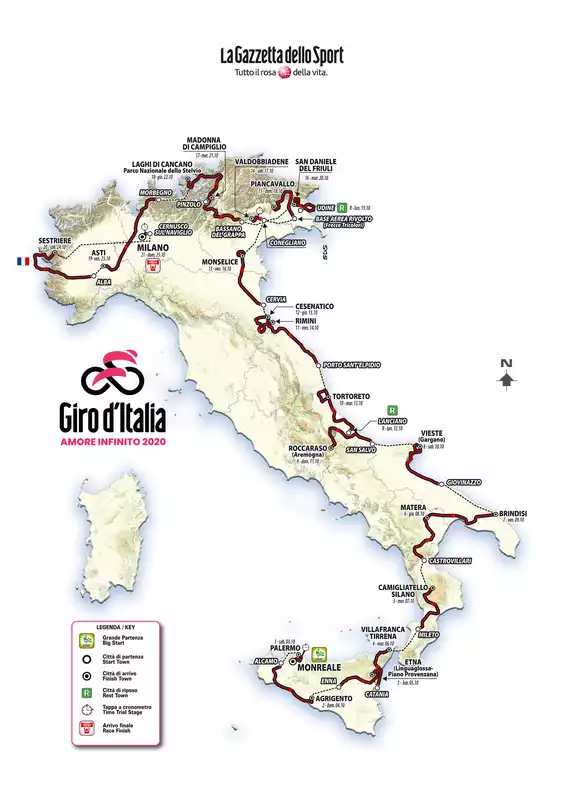The revised route for the 2020 Giro d'Italia has been announced by organizer RCS Sport. Finishes at the top of Matera and Roccaraso have been added to the opening week, replacing the road stages that were cancelled in Hungary.
As announced last week, the Corsa Rosa will start in Sicily on Saturday, October 3 with a short downhill time trial from Monreale to Palermo. The final week includes a tough mountain stage to Sestriere, followed by a 16.5km time trial in Milan on October 25.
The 2020 Giro was originally scheduled to start in Budapest on May 9, but was postponed to March due to the COVID-19 coronavirus pandemic, and race director Mauro Veni later decided not to hold the Grande Partenza in Hungary.
The first Italian stage on the original 2020 Giro route was already scheduled to take place in Sicily, as was the Grande Partenza for the 2021 race. Last week, RCS Sport announced that Sicily will host the opening four stages of the 2021 Giro.
The Giro will start with a 15km individual time trial, with riders descending from the Norman-Byzantine cathedral in Monreale to the center of Palermo.
In addition to two-time winner Vincenzo Nibali, the 2020 Giro will feature Peter Sagan (Bora-Hansgrohe), Simon Yates (Mitchelton Scott), Remco Evenpole (Detunink-Quickstep), and defending champion Richard Kalapas (Team Ineos) will compete.
The first summit finish will be on stage 3, with Gruppo taking a new approach up Mount Etna from Linguagrossa, and the first day on the Italian mainland will be on stage 5 from Milate to Camigliatello Silano.
The following day, stage 6 will ride from Castrovillari to the coastline of Basilicata, with a finale in Matera, famous for its ancient cave dwellings, the Sassi. John Degenkolb won the Giro's last visit to Matera in 2013.
After the sprinters' stage finishes in Brindisi and Vieste on the Puglia coast, the last major change to the Giro's route will come on stage 9, which starts in San Salvo and ends with a summit finish in Roccaraso.
Tim Wellens won on the summit of Abruzzo in 2016, and past winners include Fausto Coppi (1953), Bernard Inaud (1980), and Moreno Argentin (1987).
The addition of a summit finish will close the opening week of the 2020 Giro. After a rest day, racing will resume with a stage from Lanciano to Tortoreto, and the race will then continue northward on the previously outlined route.
Highlights of the second week include stage 12, which starts and finishes in Cesenatico, and stage 13, which celebrates the 50th anniversary of the Nove Colli Gran Fondo.
The third weekend of the Giro could play an important role in stage 14, a 33-km individual time trial through prosecco country from Conegliano to Valdobbiadene, before a summit finish in Piacavallo in the Carnic Alps on stage 15.
The final week of the Giro will be as grueling as ever. Stage 17 features the Forcella Valbona, Monte Bondone, and Passo Dulone climbs, totaling more than 5,100 meters before a summit finish at Madonna di Campiglio. [Campo Carlo Magno (14.3 km, 6%), Via Castolin (23.7 km, 4.7%), and Prato all Stelvio (24.7 km, 7.5%), the race's highest peak Stelvio, with its hairpin garland, await. The stage concludes with a summit finish at Laghi di Cancano, 5,400 meters above sea level.
The Giro concludes with a 16.5 km flat and fast time trial from Cernusco sul Naviglio to Milan, with the finale in Piazza del Duomo.
The grand finale takes place on the same day as the men's and women's editions of Paris-Roubaix and the first summit finish in Tourmalet in the Vuelta a España.
Speaking to La Gazzetta dello Sport on Thursday, UCI President David Lapartiento defended the overlap of major races on the "Super Sunday" of October 25, adding that the UCI has asked RCS Sport to move the Giro up one day so that it would not clash with Paris-Roubaix, adding.
"The three races will be scheduled differently so that they do not clash in the TV coverage," La Partiente said.
The Giro d'Italia is scheduled to finish in the evening, just before the autumn nights arrive in Milan.
.

Comments